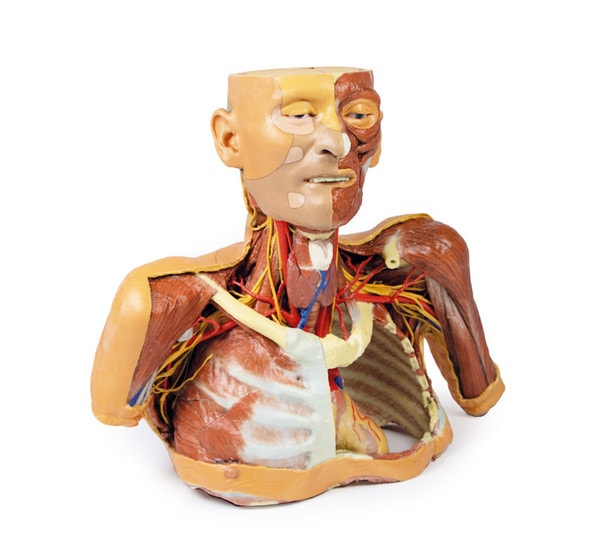Description
This 3D model of the head and neck represents a specimen sectioned just off the midsagittal plane to retain some midline anatomical structures (e.g., the falx cerebri, the septum pellucidum, the nasal septum) that are absent from other specimens in the series. There has also been fixative-induced shrinkage of the neural tissue. This reduction in volume has the benefit of exaggerating the space between the brain and endocranial contours and structures which are normally in closer approximation. The undissected side of the specimen has been digitally removed.
The anterior part of the falx cerebri has been retained from its anterior attachment at the crista galli to roughly the midpoint of its extent towards the tentorium cerebelli. At the attachment of the falx part of the dura has been removed to demonstrate the extent of the superior sagittal sinus within the retained portion of the dural infold. The brain itself has been sectioned with preservation of the septum pellucidum and the interventricular foramen (of Monro) defining the passageway between the deep lateral ventricle and sectioned third ventricle. This section plane also captures the infundibulum extending from the hypothalamus to the pituitary gland, which is seated adjacent to a well-developed sphenoid sinus. Both the cerebral aqueduct and fourth ventricle are preserved, as are parts of the left vertebral artery, left posterior cerebral (in cross-section) and the branches of the anterior cerebral artery passing around the corpus callosum.
The retention of the nasal septum in this specimen (and in contrast to other 3D models of the head and neck in the series) allows for an appreciation of the relationship between the septum and the hard and soft palates, the entrance of the auditory tube, and the overall nasopharynx relative to the nasal cavity and oropharyngeal region inferior to it. The muscular wall of the pharynx has been isolated to demonstrate the position relative to the cervical vertebral column. Inferiorly, the tracheal cartilages including the epiglottis, arytenoid and thyroid have been retained to demonstrate the position of these cartilages relative to the hyoid bone, as well as the vestibule, vestibular fold, and vocal fold in cross-section.
Advantages of 3D Printed Anatomical Models
- 3D printed anatomical models are the most anatomically accurate examples of human anatomy because they are based on real human specimens.
- Avoid the ethical complications and complex handling, storage, and documentation requirements with 3D printed models when compared to human cadaveric specimens.
- 3D printed anatomy models are far less expensive than real human cadaveric specimens.
- Reproducibility and consistency allow for standardization of education and faster availability of models when you need them.
- Customization options are available for specific applications or educational needs. Enlargement, highlighting of specific anatomical structures, cutaway views, and more are just some of the customizations available.
Disadvantages of Human Cadavers
- Access to cadavers can be problematic and ethical complications are hard to avoid. Many countries cannot access cadavers for cultural and religious reasons.
- Human cadavers are costly to procure and require expensive storage facilities and dedicated staff to maintain them. Maintenance of the facility alone is costly.
- The cost to develop a cadaver lab or plastination technique is extremely high. Those funds could purchase hundreds of easy to handle, realistic 3D printed anatomical replicas.
- Wet specimens cannot be used in uncertified labs. Certification is expensive and time-consuming.
- Exposure to preservation fluids and chemicals is known to cause long-term health problems for lab workers and students. 3D printed anatomical replicas are safe to handle without any special equipment.
- Lack of reuse and reproducibility. If a dissection mistake is made, a new specimen has to be used and students have to start all over again.
Disadvantages of Plastinated Specimens
- Like real human cadaveric specimens, plastinated models are extremely expensive.
- Plastinated specimens still require real human samples and pose the same ethical issues as real human cadavers.
- The plastination process is extensive and takes months or longer to complete. 3D printed human anatomical models are available in a fraction of the time.
- Plastinated models, like human cadavers, are one of a kind and can only showcase one presentation of human anatomy.
Advanced 3D Printing Techniques for Superior Results
- Vibrant color offering with 10 million colors
- UV-curable inkjet printing
- High quality 3D printing that can create products that are delicate, extremely precise, and incredibly realistic
- To improve durability of fragile, thin, and delicate arteries, veins or vessels, a clear support material is printed in key areas. This makes the models robust so they can be handled by students easily.
























